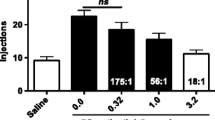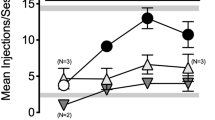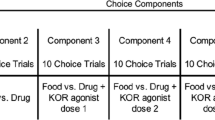Abstract
Rationale
Triazole 1.1 is a novel kappa-opioid receptor (KOR) agonist reported to produce antinociception without KOR-typical adverse effects. When combined with the mu-opioid receptor (MOR) agonist, oxycodone, triazole 1.1 blocks oxycodone-induced pruritis without producing sedation-like effects in nonhuman primates. However, it is unknown if triazole 1.1 can reduce the abuse-related effects or enhance the antinociceptive effects of oxycodone similarly to other KOR agonists.
Objectives
The aim of the present study was to quantitatively compare the behavioral effects of triazole 1.1 to the KOR agonists, U50,488h and nalfurafine, on oxycodone self-administration and oxycodone-induced thermal antinociception when administered as mixtures with oxycodone.
Methods
In the self-administration study, male Sprague–Dawley (SD) rats (n = 6) self-administered intravenous (i.v.) oxycodone alone (0.056 mg/kg/inj) or combined with U50,488 h (0.032-0.32 mg/kg/inj), nalfurafine (0.00032–0.0032 mg/kg/inj), or triazole 1.1 (0.32–1.8 mg/kg/inj) under a progressive-ratio schedule of reinforcement. In a hot plate assay, male SD rats (n = 6) received i.v. injections of oxycodone (1.0-5.6 mg/kg), U50,488h (1.0-18.0 mg/kg), nalfurafine (0.01-1.0 mg/kg), or triazole 1.1 (3.2-32.0 mg/kg) alone or in combinations of fixed proportion with oxycodone based on the relative potencies of the single drugs. Each study concluded with administration of the KOR antagonist nor-BNI and some degree of retesting of the previous conditions to verify that the behavioral effects were mediated by KOR activation.
Results
All KOR agonists reduced oxycodone self-administration in a dose-dependent manner. Moreover, all single drugs and drug combinations produced dose-dependent, fully efficacious thermal antinociception. All KOR agonist:oxycodone combinations produced either additive or super-additive thermal antinociception. Finally, each KOR agonist was blocked in effect by nor-BNI in both behavioral measures.
Conclusion
This study demonstrates that triazole 1.1 reduces oxycodone’s reinforcing effects and enhances oxycodone-induced antinociception to degrees that are comparable to typical KOR agonists. Given triazole 1.1’s mild adverse-effect profile, developing MOR-KOR agonist combinations from the triazole 1.1 series may render new pain therapeutics with reduced abuse liability.



Similar content being viewed by others
References
Banks ML, Negus SS (2017) Insights from preclinical choice models on treating drug addiction. Trends Pharmacol Sci 38:181–194. https://doi.org/10.1016/j.tips.2016.11.002
Beck TC, Hapstack MA, Beck KR, Dix TA (2019) Therapeutic potential of kappa opioid agonist. Pharmaceuticals 12:95. https://doi.org/10.1007/s00213-008-1458
Becker JB, Chartoff E (2019) Sex differences in neural mechanisms mediating reward and addiction. Neuropsychopharmacology 44:166–183. https://doi.org/10.1038/s41386-018-0125-6
Bedini A, Di Cesare ML, Micheli L, Baiula M, Vaca G, De Marco R et al (2020) Functional selectivity and antinociceptive effects of a novel KOPr agonist. Front Pharmacol 11:188. https://doi.org/10.3389/fphar.2020.00188
Bolanos CA, Garmsen GM, Clair MA, McDougall SA (1996) Effects of the kappa-opioid receptor agonist U-50,488 on morphine-induced place preference conditioning in the developing rat. Eur J Pharmacol 317:1–8. https://doi.org/10.1016/s0014-2999(96)00698-x
Bruijnzeel AW (2009) Kappa-opioid receptor signaling and brain reward function. Brain Res Rev 62:127–146. https://doi.org/10.1016/j.brainresrev.2009.09.008
Brust TF, Morgenweck J, Kim SA, Rose JH, Locke JL, Schmid CL, et al (2016) Biased agonists of the kappa opioid receptor suppress pain and itch without causing sedation or dysphoria. Sci Signal 9:ra117. https://doi.org/10.1126/scisignal.aai8441
Briggs SL, Rech RH (2009) Antinociceptive interactions of micro- and kappa- opioid agonists in the colorectal distension assay in rats. Pharmacol Biochem Behav 92:343–350. https://doi.org/10.1016/j.pbb.2008.12.023
Cao D, Huang P, Chiu YT, Chen C, Wang H, Li M et al (2020) Comparison of pharmacological properties between kappa opioid receptor agonist nalfurafine and 42B, its 3-dehydroxy analogue: disconnect between in vitro agonist bias and in vivo pharmacological effects. ACS Chem Neurosci 11:3026–3050. https://doi.org/10.1021/acschemneuro.0c00407
Chartoff EH, Mavrikaki M (2015) Sex Differences in kappa opioid receptor function and their potential impact on addiction. Front Neurosci 9:466. https://doi.org/10.3389/fnins.2015.00466
Chan HCS, McCarthy D, Li J, Palczewski K, Yuan S (2017) Designing safer analgesics via μ-opioid receptor pathways. Trends Pharmacol Sci 38:1016–1037. https://doi.org/10.1016/j.tips.2017.08.004
Crowley NA, Kash TL (2015) Kappa opioid receptor signaling in the brain: circuitry and implications for treatment. Prog Neuropsychopharmacol Bio Psychiatry 62:51–60. https://doi.org/10.1016/j.pnpbp.2015.01.001
de Costa BR, Nuesch E, Kasteler R, Husni E, Welch V, Rutjex, AWS, et al (2014) Oral or transdermal opioids for osteoarthritis of the knee or hip. Cochrane Database Syst Rev CD003115. https://doi.org/10.1002/14651858.CD003115.pub4
Dunn AD, Reed B, Guariglia C, Dunn AM, Hillman JM, Kreek MJ (2018) Structurally Related kappa opioid receptor agonists with substantial differential signaling bias: neuroendocrine and behavioral effects in C57BL6 mice. Int J Neuropsychopharmacol 21:847–857. https://doi.org/10.1093/ijnp/pyy034
Endoh T, Tajima A, Suzuki T, Kamei J, Narita M, Tseng L, Nagase H (2000) Characterization of the antinociceptive effects of TRK-820 in the rat. Eur J Pharmacol 387:133–140. https://doi.org/10.1016/s0014-2999(99)00815-8
Flax SM, Wakeford AG, Cheng K, Rice KC, Riley AL (2015) Effect of norbinaltorphimine on (9)-tetrahydrocannabinol (THC)-induced taste avoidance in adolescent and adult Sprague-Dawley rats. Psychopharmacology 232:3193–3201. https://doi.org/10.1007/s00213-015-3970-6
Freeman KB, Naylor JE, Prisinzano TE, Woolverton WL (2014) Assessment of the kappa opioid agonist, salvinorin A, as a punisher of drug self-administration in monkeys. Psychopharmacology 231:2751–2758. https://doi.org/10.1007/s00213-014-3436-2
Glick SD, Maisonneuve IM, Raucci J, Archer S (1995) Kappa opioid inhibition of morphine and cocaine self-administration in rats. Brain Res 681:147–152. https://doi.org/10.1016/0006-8993(95)00306-b
Huskinson SL, Platt DM, Brasfield M, Follett ME, Prisinzano TE, Blough BE et al (2020) Quantification of observable behaviors induced by typical and atypical kappa-opioid receptor agonists in male rhesus monkeys. Psychopharmacology. https://doi.org/10.1007/s00213-020-05519-7
Inan S, Huerta AT, Jensen LE, Dun NJ, Cowan A (2019) Nalbuphine, a kappa opioid receptor agonist and mu opioid receptor antagonist attenuates pruritus, decreases IL-31, and increases IL-10 in mice with contact dermatitis. Eur J Pharmacol 864:172702. https://doi.org/10.1016/j.ejphar.2019.172702
Jones MR, Kaye AD, Kaye AJ, Urman RD (2016) The emerging therapeutic roles of kappa-opioid agonists. J Opioid Manag 12:101–107. https://doi.org/10.5055/jom.2016.0321
Kamimura K, Yokoo T, Kamimura H, Sakamaki A, Abe S, Tsuchiya A et al (2017) Long-term efficacy and safety of nalfurafine hydrochloride on pruritus in chronic liver disease patients: patient-reported outcome based analyses. PLoS ONE 12:e0178991. https://doi.org/10.1371/journal.pone.0178991
Kaski SW, White AN, Gross JD, Trexler KR, Wix K, Harland AA et al (2019) Preclinical testing of nalfurafine as an opioid-sparing adjuvant that potentiates analgesia by the mu opioid receptor-targeting agonist morphine. J Pharmacol Exp Ther 371:487–499. https://doi.org/10.1124/jpet.118.255661
Ko MC, Husbands SM (2009) Effects of atypical kappa-opioid receptor agonists on intrathecal morphine-induced itch and analgesia in primates. J Pharmacol Exp Ther 328:193–200. https://doi.org/10.1124/jpet.108.143925
Kumagai H, Ebata T, Takamori K, Miyasato K, Muramatsu T, Nakamoto H et al (2012) Efficacy and safety of novel κ-agonist for managing intractable pruritus in dialysis patients. Am J Nephrol 36:175–183. https://doi.org/10.1159/000341268
Kumagai H, Ebata T, Takamori K, Muramatsu T, Nakamoto H, Suzuki H (2010) Effect of a novel kappa-receptor agonist, nalfurafine hydrochloride, on sever itch in 337 haemodialysis patients: a phase III, randomized, double-blind, placebo-controlled study. Nephrol Dial Transplant 25:1251–1257. https://doi.org/10.1093/ndt/gfp588
Lawson KP, Nag S, Thompson AD, Mokha SS (2010) Sex-specificity and estrogen-dependence of kappa opioid receptor-mediated antinociception and antihyperalgesia. Pain 151:806–815. https://doi.org/10.1016/j.pain.2010.09.018
Lazenka ML, Moerke MJ, Townsend EA, Freeman KB, Carroll FI, Negus SS (2018) Dissociable effects of the kappa opioid receptor agonist nalfurafine on pain/itch-stimulated and pain/itch-depressed behaviors in male rats. Psychopharmacology 235:203–213. https://doi.org/10.1007/s00213-017-4758-7
Legakis LP, Karim-Nejad L, Negus SS (2020) Effects of repeated treatment with monoamine-transporter-inhibitor antidepressants on pain-related depression of intracranial self-stimulation in rats. Psychopharmacology 237:2201–2212. https://doi.org/10.1007/s00213-020-05530-y
Leighton GE, Rodriguez RE, Hill RG, Hughes J (1988) Kappa-opioid agonists produce antinociception after i.v. and i.c.v. but not intrathecal administration in the rat. Br J Pharmacol 93:553–560. https://doi.org/10.1111/j.1476-5381.1988.tb10310.x
Leitl MD, Potter DN, Cheng K, Rice KC, Carlezon WA, Negus SS (2014) Sustained pain-related depression of behavior: effects of intraplantar formalin and complete freund’s adjuvant on intracranial self-stimulation (ICSS) and endogenous kappa opioid biomarkers in rats. Mol Pain 10:62. https://doi.org/10.1186/1744-8069-10-62
Leppert W, Malec-Milewska M, Zajaczkowska R, Wordliczek J (2018) Transdermal and Topical Drug Administration in the Treatment of Pain. Molecules 23:681. https://doi.org/10.3390/molecules23030681
Liu JJ, Chiu YT, Dimattio KM, Chen C, Huang P, Gentile TA et al (2019) Phosphoproteomic approach for agonist-specific signaling in mouse brains: mTOR pathway is involved in κ opioid aversion. Neuropsychopharmacol 44:939–949. https://doi.org/10.1038/s41386-018-0155-0
Liu NJ, Schnell S, Wessendorf MW, Gintzler AR (2013) Sex, pain, and opioids: interdependent influences of sex and pain modality on dynorphin-mediated antinociception in rats. J Pharmacol Exp Ther 344:522–530. https://doi.org/10.1124/jpet.112.199851
MacLean KA, Johnson MW, Reissig CJ, Prisinzano TE, Griffiths RR (2013) Dose-related effects of salvinorin A in humans: dissociative, hallucinogenic, and memory effects. Psychopharmacology 226:381–392. https://doi.org/10.1007/s00213-012-2912-9
McCurdy CR, Sufka KJ, Smith GH, Warnick JE, Nieto MJ (2006) Antinociceptive profile of salvinorin A, a structurally unique kappa opioid receptor agonist. Pharmacol Biochem Behav 83:109–113. https://doi.org/10.1016/j.pbb.2005.12.011
Melief EJ, Miyatake M, Carroll FI, Beguin C, Carlezon WA, Cohen BM et al (2011) Duration of action of a broad range of selective κ-opioid receptor antagonists is positively correlated with C-Jun N-terminal kinase-1 activation. Mol Pharmacol 80:920–929. https://doi.org/10.1124/mol.111.074195
Miaskowski C, Sutters KA, Taiwo YO, Levine JD (1992) Antinociceptive and motor effects of delta/mu and kappa/mu combinations of intrathecal opioid agonists. Pain 49:137–144. https://doi.org/10.1016/0304-3959(92)90200-u
Minervini V, Lu HY, Padarti J, Osteicoechea DC, France CP (2018) Interactions between kappa and mu opioid receptor agonists: effects of the ratio of drugs in mixtures. Psychopharmacology 235:2245–2256. https://doi.org/10.1007/s00213-018-4920-x
Mores KL, Cummins BR, Cassell RJ, van Rijn RM (2019) A review of the therapeutic potential of recently developed G protein-biased kappa agonists. Front Pharmacol 10:407. https://doi.org/10.3389/fphar.2019.00407
Negus SS, Morrissey EM, Rosenberg M, Cheng K, Rice KC (2010) Effects of kappa opioids in an assay of pain-depressed intracranial self-stimulation in rats. Psychopharmacology 210:149–159. https://doi.org/10.1007/s00213-009-1770-6
Negus SS, Neddenriep B, Altarifi AA, Carroll FI, Leitl MD, Miller LL (2015) Effects of ketoprofen, morphine, and kappa opioids on pain-related depression of nesting in mice. Pain 156:1153–1160. https://doi.org/10.1097/j.pain.0000000000000171
Negus SS, O’Connell R, Morrissey E, Cheng K, Rice KC (2012) Effects of peripherally restricted κ opioid receptor agonists on pain-related stimulation and depression of behavior in rats. J Pharmacol Exp Ther 340:501–509. https://doi.org/10.1124/jpet.111.186783
Negus SS, Schrode K, Stevenson GW (2008) Micro/kappa opioid interactions in rhesus monkeys: implications for analgesia and abuse liability. Exp Clin Psychopharmacol 16:386–399. https://doi.org/10.1037/a0013088
Negus SS, Zuzga DS, Mello NK (2002) Sex differences in opioid antinociception in rhesus monkeys: antagonism of fentanyl and U50,488 by quadazocine. J Pain 3:218–226. https://doi.org/10.1054/jpai.2002.124734
Ranganathan M, Schnakenberg A, Skosnik PD, Cohen BM, Pittman B, Sewell RA et al (2012) Dose-related behavioral, subjective, endocrine, and psychophysiological effects of the kappa opioid agonist salvinorin A in humans. Biol Psychiatry 72:871–879. https://doi.org/10.1016/j.biopsych.2012.06.012
Rankovic Z, Brust TF, Bohn LM (2016) Biased agonism: an emerging paradigm in GPCR drug discovery. Bioorg Med Chem Lett 26:241–250. https://doi.org/10.1016/j.bmcl.2015.12.024
Schattauer SS, Kuhar JR, Song A, Chavkin C (2017) Nalfurafine is a G-protein biased agonist having significantly greater bias at the human than rodent form of the kappa opioid receptor. Cell Signal 32:59–65. https://doi.org/10.1016/j.cellsig.2017.01.016
Shippenberg TS, Chefer VI, Zapata A, Heidbreder CA (2001) Modulation of the behavioral and neuroshemical effects of psychostimulants by kappa-opioid receptor systems. Ann N Y Acad Sci 937:50–73. https://doi.org/10.1111/j.1749-6632.2001.tb03558.x
Tallarida RJ (2000) Drug synergism and dose-effect data analysis. Champman and Hall/CRC, Boca Raton
Tallarida RJ (2012) Revisiting the isoboloe and related quantitative methods for assessing drug synergism. J Pharmacol Exp Ther 342:2–8. https://doi.org/10.1124/jpet.112.193474
Thomsen M, Woldbye DP, Wortwein G, Fink-Jensen A, Wess J, Caine SB (2005) Reduced cocaine self-administration in muscarinic M5 acetylcholine receptor-deficient mic. J Neurosci 25:8141–8149. https://doi.org/10.1523/JNEUROSCI.2077-05.2005
Townsend EA (2021) Effects of kappa opioid receptor agonists on fentanyl vs. food choice in male and female rats: contingent vs. non-contingent administration. Psychopharmacology (Berl) https://doi.org/10.1007/s00213-020-05749-9
Townsend EA, Naylor JE, Negus SS, Edwards SR, Qureshi HN, McLendon HW (2017) Effects of nalfurafine on the reinforcing, thermal antinociceptive, and respiratory-depressant effects of oxycodone: modeling an abuse-deterrent opioid analgesic in rats. Psychopharmacology 234:2597–2605. https://doi.org/10.1007/s00213-017-4652-3
Urban JD, Clarke WP, von Zastrow M, Nichols DE, Kobilka B, Weinstein H et al (2007) Functional selectivity and classical concepts of quantitative pharmacology. J Pharmacol Exp Ther 320:1–13. https://doi.org/10.1124/jpet.106.104463
Xi ZX, Fuller SA, Stein EA (1998) Dopamine release in the nucleus accumbens during heroin self-administration is modulated by kappa opioid receptors: an in vivo fast-cyclic voltammetry study. J Pharmacol Exp Ther 24:151–161
Zamarripa CA, Naylor JE, Huskinson SL, Townsend EA, Prisinzano TE, Freeman KB (2020a) Kappa opioid agonists reduce oxycodone self-administration in male rhesus monkeys. Psychopharmacology 237:1471–1480. https://doi.org/10.1007/s00213-020-05473-4
Zamarripa CA, Patel TR, Williams BC, Pareek T, Schrock HM, Prisinzano TE, Freeman KB (2020b) The kappa-opioid receptor agonist, nalfurafine, blocks acquisition of oxycodone self-administration and oxycodone’s conditioned rewarding effects in male rats. Behav Pharmacol. https://doi.org/10.1097/FBP.0000000000000581
Zamarripa CA, Edwards SR, Qureshi HN, Yi JN, Blough BE, Freeman KB (2018) The G-protein biased mu-opioid agonist, TRV130, produces reinforcing and antinociceptive effects that are comparable to oxycodone in rats. Drug Alcohol Depend 192:158–162. https://doi.org/10.1016/j.drugalcdep.2018.08.002
Zhang Y, Kreek MJ (2020) Nalfurafine modulates the reinforcing effects of oxycodone in male and female adolescent C57BL/6J mice. Neuropharmacology 176:108244. https://doi.org/10.1016/j.neuropharm.2020.108244
Zhou L, Lovell KM, Franskowski KJ, Slauson SR, Philips AM, Streicher JM et al (2013) Development of functionally selective, small molecule agonists at kappa opioid receptors. J Bio Chem 288:36703-36716. https://doi.org/10.1074/jbc.M113.504381
Funding
This research was supported by National Institute on Drug Abuse grants DA039167 to K.B.F., DA048586 to C.A.Z., and DA018151 to T.E.P.
Author information
Authors and Affiliations
Corresponding author
Ethics declarations
Conflict of interest
The authors declare no competing interests.
Additional information
Publisher’s note
Springer Nature remains neutral with regard to jurisdictional claims in published maps and institutional affiliations.
Supplementary Information
Below is the link to the electronic supplementary material.
Rights and permissions
About this article
Cite this article
Zamarripa, C.A., Pareek, T., Schrock, H.M. et al. The kappa-opioid receptor agonist, triazole 1.1, reduces oxycodone self-administration and enhances oxycodone-induced thermal antinociception in male rats. Psychopharmacology 238, 3463–3476 (2021). https://doi.org/10.1007/s00213-021-05965-x
Received:
Accepted:
Published:
Issue Date:
DOI: https://doi.org/10.1007/s00213-021-05965-x




